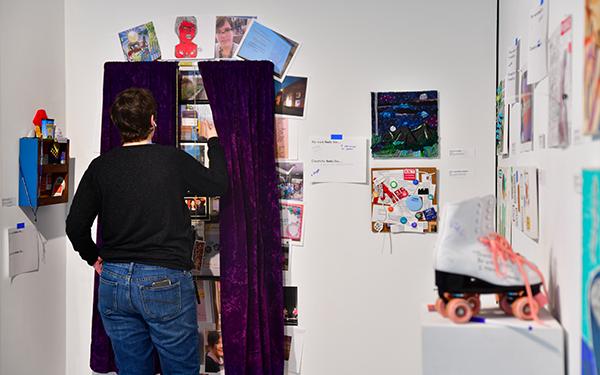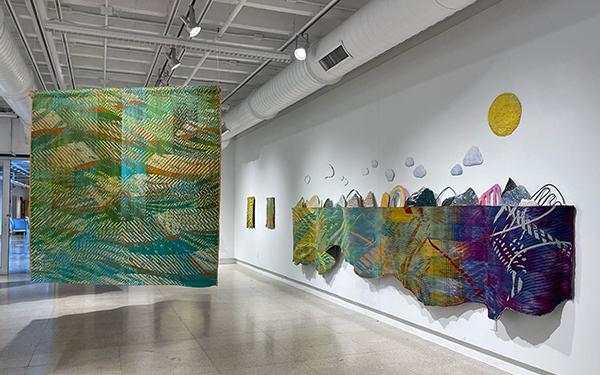Introduction
Dear Friends,
The Ohio State University’s Urban Arts Space facilitates an experimental gallery that adapts to the dynamic needs of arts research, arts curriculum and the surrounding community. Established in 2008, Urban Arts Space is located downtown Columbus, about 2 miles from OSU’s campus. Urban Arts Space also encompasses Hopkins Hall Gallery, a satellite gallery on Ohio State’s main campus—as well as UAS Online. All Urban Arts Space events and exhibitions are always free and open to the public.
In February 2020, right before the global pandemic set in, Urban Arts Space launched its new, five-year strategic plan with a mission to strengthen its collaborations, deepen learning, and increase access to the arts. The conditions and restrictions of the pandemic challenged our collective norms for presenting art and collaborating with each other. However, with a strong plan as our guidepost, we capitalized on achieving two goals this past year:
- Implement the new plan’s strategic priorities
- Respond to emerging needs posed by pandemic conditions
Among strategic priorities, UAS focused primarily on experience (teaching, learning, and participation) and engagement, through the implementation of a new programming model designed to respond to the needs of the university’s arts units during a pandemic year, including:
- Communication and cross-disciplinary work across visual arts units and media
- Democratic decision making with clear rules of use and expectations/guidelines, accessible and low-barrier entry; focus on visual arts curriculum and research
- User-friendly experiences; internal focus on university audiences and particpants
- Play space for making and performing; accessible to multidisciplinary groups.
- The encouragement and dissemination of arts-based research, negotiations, and discussions, actively supporting the learning and knowledge sharing the university and the arts foster.
As a result of timely strategic planning, our spaces (Urban Arts Space, Hopkins Hall Gallery and UAS Online) featured one of the most vibrant seasons of arts sharing yet, through rapidly evolving hybrid and online content and programming. Hybrid Arts Lab, was conceived in an afternoon planning session with arts faculty leaders in June 2020 and led to the successful delivery of a pilot in Autumn 2020. Our conversation evolved around the question: “what it would look like if we experimented with how art is imagined, made, viewed, and understood?” Many viable ideas—and pressing instructional needs—emerged from our discussion; Hybrid Arts Lab encompasses much of that through making the arts visible across the university and beyond. We dedicated three venues to the project: our campus gallery in Hopkins Hall, an outdoor tent installed outside of Stillman Hall, and our new online platform, UAS Online, for virtual arts presentation. The tent was a temporary addition but provided an important space and resource during Autumn 2020. Hybrid Arts Lab continued robustly in Spring 2021 at Hopkins Hall Gallery and UAS Online as the project gained broad recognition, support, and visibility on campus. The Hybrid Arts Lab programming model remains valid in the coming year as Urban Arts Space continues to respond to the need for agile, collaborative, and experimental arts research, making, teaching, and programming opportunities.
Sincerely,
Merijn van der Heijden
Director, Urban Arts Space
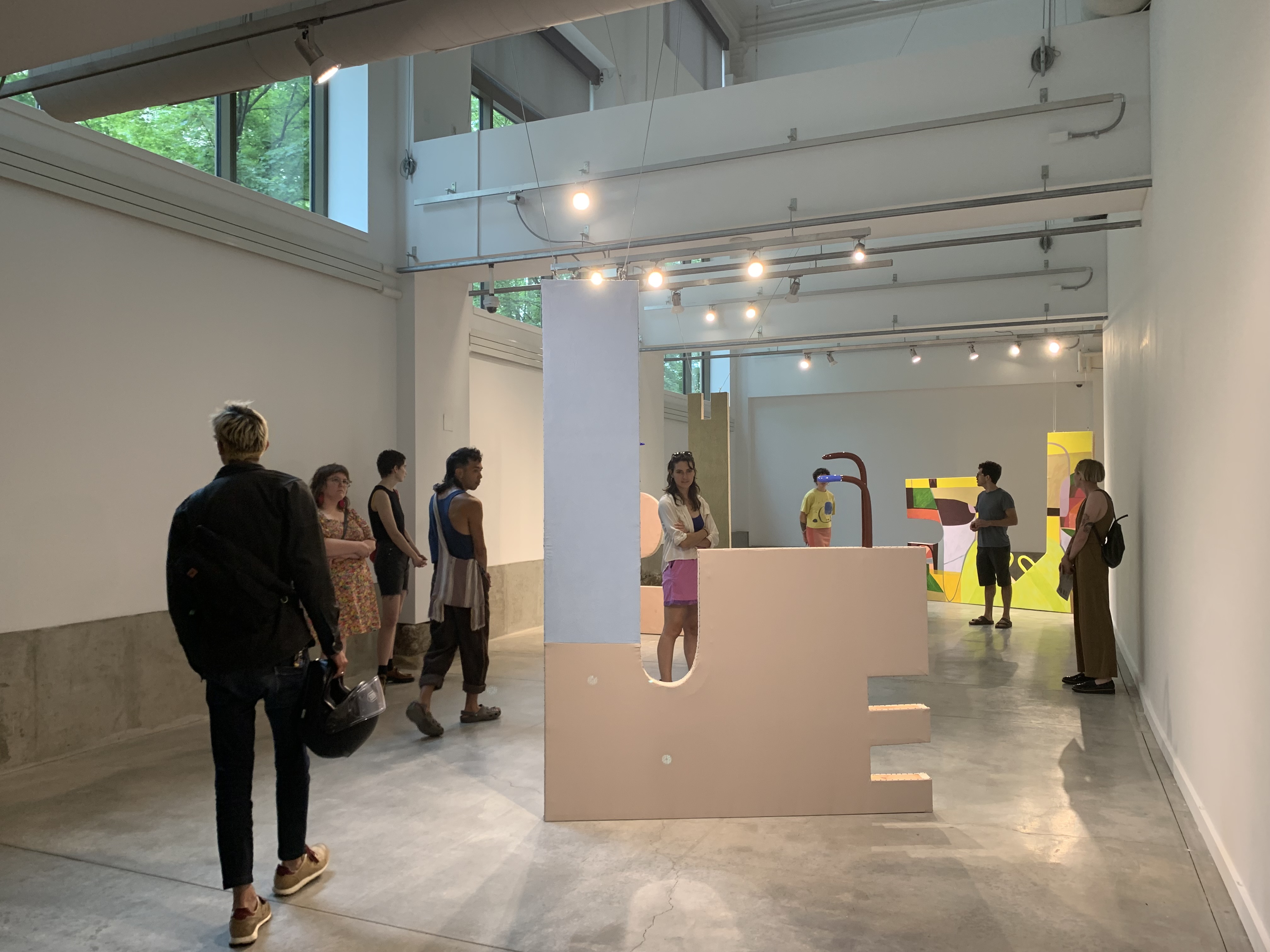
About UAS, HHG and UAS Online
Urban Arts Space is a College-wide, arts centric, resource that actively promotes the College’s core values of teaching/learning and outreach/engagement through the arts. Urban Arts Space first opened its doors in the downtown historic Lazarus Building in 2008 with a three-fold mission: to strategically contribute to the downtown community; to serve as a storefront exhibition and performance space for faculty research and student achievements; and to serve as a place where students gain hands-on experiential learning in a professional, yet "safe," environment. Since its founding, UAS has expanded its footprint to include Hopkins Hall Gallery on campus and UAS Online—a new, online venue for arts presentation and circulation.
In addition to serving as a laboratory for the tagged degree programs in the arts, Urban Arts Space showcases work by artists of national and international note, including Ohio State faculty. For a more extensive roster of UAS’ community programming, see UAS’ searchable exhibitions and events roster and exhibitions archive on the UAS website. As part of its mission to challenge perceptions, deepen learning, and increase access to the arts, Urban Arts Space engages audiences (including K-12) through educational programming, classes, summer camps, and tours (all free of charge.)
In 2020, a renewed emphasis on fulfilling the visual arts units’ curriculum led to the successful implementation of Hybrid Arts Lab (which was conceived in direct response to the significant limitations on modes of expression in the visual arts imposed by the COVID-19 pandemic.) And while the pandemic severely restricted our in-person offerings, engagement, and programming, Urban Arts Space strengthened its online presence during the pandemic year.
Mission
To challenge perceptions, deepen learning, and increase access to the arts.
Vision
Vibrant arts experiences between
campus and community.
Values
Creativity
Cultivating ideas and experimenting with how art is imagined, made, viewed, and understood is fundamental to our purpose.
Access
Every exhibition increases opportunities for artists to make, and audiences to experience, art.
Curriculum
A thriving student experience is driven by the arts departments' curriculum.
Connections
We foster conversations, relationships, and careers that represent and welcome diverse perspectives.
Exploration
Participating in the cultural life of the city deepens students’ understanding and broadens their horizons.
AU20-SU21 Highlights
Throughout the year, the team at Urban Arts Space and Hopkins Hall Gallery focused on an exciting suite of new hybrid and virtual programming via Hopkins Hall Gallery, Urban Arts Space, and UAS From Home. In response to the need for agile and safe exhibition and arts programming spaces, in Summer 2020 we introduced an exclusively virtual Summer Series and a brand new pilot, Hybrid Arts Lab. Most excitedly, Hybrid Arts Lab offered a peek behind the scenes, increasing visibility of arts teaching, research, and studio practice through live sessions, exhibitions, programming and interviews. In addition to facilitating these spaces for creative activity, Urban Arts Space coordinated the circulation of Hybrid Arts Lab activities through a range of communications strategies including newsletters, social media, web events, virtual/live programming and walkthroughs and more.
41
CLASSES SUPPORTED
1699
STUDENTS & FACULTY ENGAGED
108
EXHIBITIONS,
PROGRAMS & ACTIVITIES
The galleries focused on recurring exhibition and programming staples, including the Department of Design’s faculty exhibition, Making Lemonade; the Department of Art’s Bachelor of Art and Bachelor of Fine Arts Senior Projects exhibitions; Department of Dance Virtual Student Showcase; the 29th Annual Fergus Scholarship exhibition; Arts Scholars Juried exhibition; Master of Fine Arts exhibitions (In Cahoots and Proximity); Undergraduate Art Scholarships exhibition; the Department of Design Spring exhibition; the Bachelor of Fine Arts Spring Senior projects Exhibition; and monthly programming featuring free and open access online art-making programming including our Art Explorations and Crafternoons classes.
Hybrid Arts Lab
Hybrid Arts Lab ran from August 29-December 30, 2020 and from February 1-May 23, 2021, supporting a diverse range of arts classes, exhibitions, and programs across the College of Arts and Sciences, featuring 65 distinct projects, engaging nearly 900 students, faculty, and staff in the College of Arts and Sciences. For a comprehensive listing of Hybrid Arts Lab programming, please see our website for Hybrid Arts Lab’s programming archive.
Summer Series
While Summer Series 2020 was focused on exclusively online delivery of exhibitions and engagement, Summer Series 2021 brought a new round of hybrid programming, featuring 8 exhibitions, engaging 15 artists, framed specifically around ideas that foster conversations, relationships or careers that represent and welcome diverse persepectives. In addition, Summer Series 2021 encouraged collaboration and multi-disciplinary approaches.
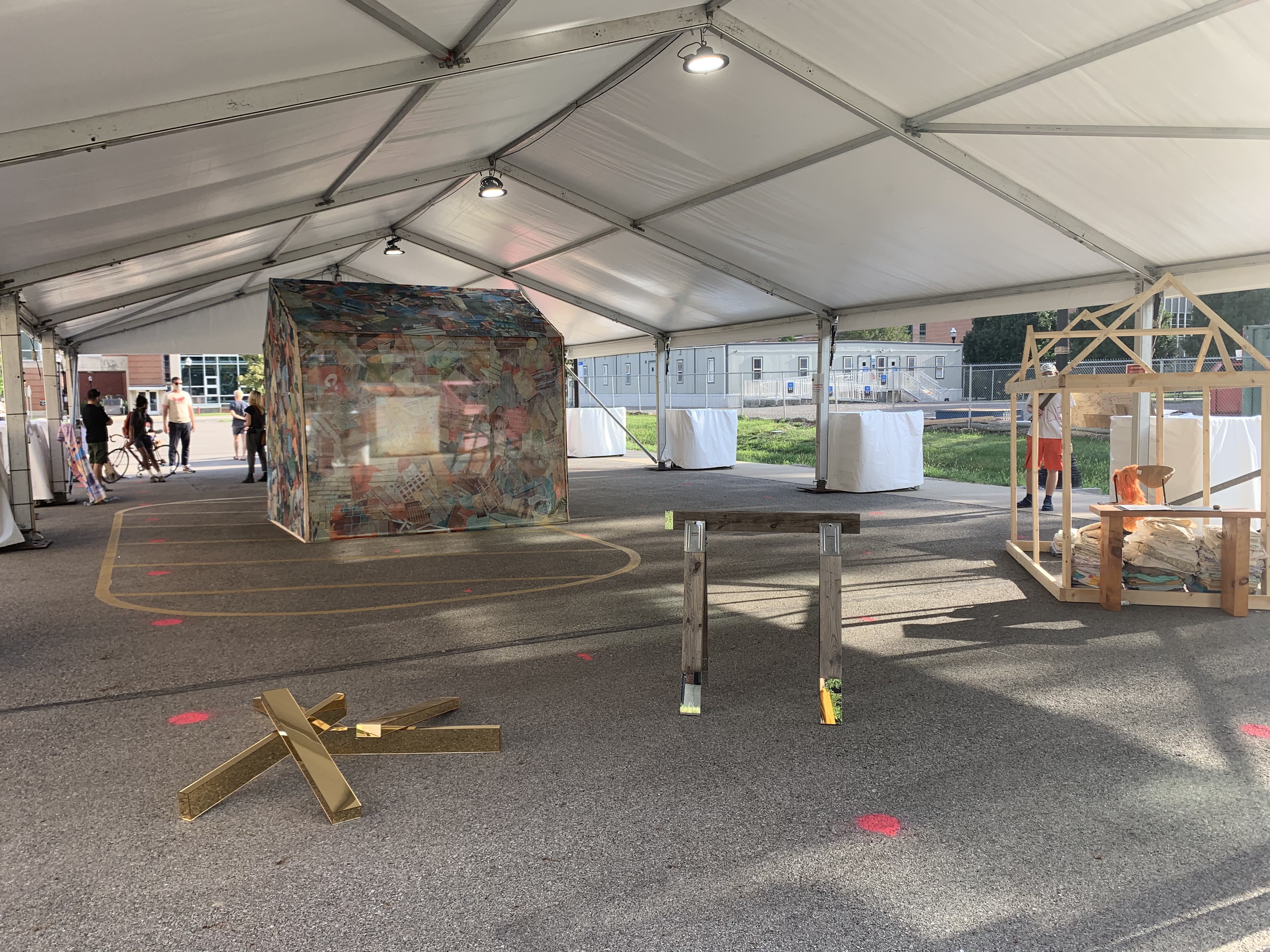
Visibility
Hybrid Arts Lab inaugural programming season kicked off On August 29, 2020, with 24 hour Drama, a half virtual / half physical exhibition organized by OSU’s Department of Art 2nd Year MFA cohort. An online component launched on Friday, August 28th at midnight and an in-person installation of the show was open to visitors on Saturday, August 29th from 12-8 pm on OSU’s campus. A Livestream walkthrough of the exhibition provided additional access and engagement opportunities. The artists leaned into the enduring chaos of the time and instead of trying to create order from disorder, allowed the exhibition and the 24- hour Drama to unfold at its own will.
Throughout FY’21 Urban Arts Space supported effective collaborations that advanced strategic priorities and lead to measurable outcomes, while remaining responsive to the university community’s everchanging environment and needs. Urban Arts Space's Hybrid Arts Lab, a multi-venue learning lab that experiments with how art is imagined, made, viewed and understood, showcased collaborative and experimental exhibitions, performances and discussions. With an inclination toward asking big questions that ignite thoughtful conversations, art makers and researchers in the College of Arts and Sciences were invited to explore new ways of integrating and circulating their creative activity, teaching and research. Initially we learned that making the exhibition time and space available was one of the most supportive and generous aspects of Hybrid Arts Lab, along with ensuring that infrastructure (space, time, dedicated staff resources) continues. However, we also learned that it was important to create a clear brand that allowed us to communicate consistently with internal and external audiences about the experimental nature of the series. Consistent communication and audience data analysis led to diverse and increased participation, attendance, and demand for exhibitions and programming.
UAS Venues
Stillman Hall Tent
During Autumn 2020 semester, three outdoor tents held spaces for physically distanced classes, rehearsals and exhibitions in the various arts units across the College of Arts and Sciences. The tent behind Stillman Hall was managed by Urban Arts Space and was part of its Hybrid Arts Lab umbrella, which also included Hopkins Hall Gallery and a virtual venue, UAS Online. The Stillman tent allowed artists to experiment with how art is made, viewed and understood, and helped test assumptions of how collaboration in the arts can happen and was available for use across all arts units in the Arts and Sciences.

Experience
Promoting experiential learning and relevant visual arts research, Urban Arts Space primarily focused on serving two functions across physical and virtual venues during FY’21:
- Direct classroom support—devising new, alternative learning environments physically and virtually
- Creative activity & research—setting up conditions that encouraged everyone to be a little “messy” and try something that could change the way they create or understand art.
A long term goal for Urban Arts Space is to expand as a full-service teaching lab for Ohio State University visual arts, and programs, and meet the unique teaching and learning needs of faculty, students and particpants through an experimental space.
Signature Programs
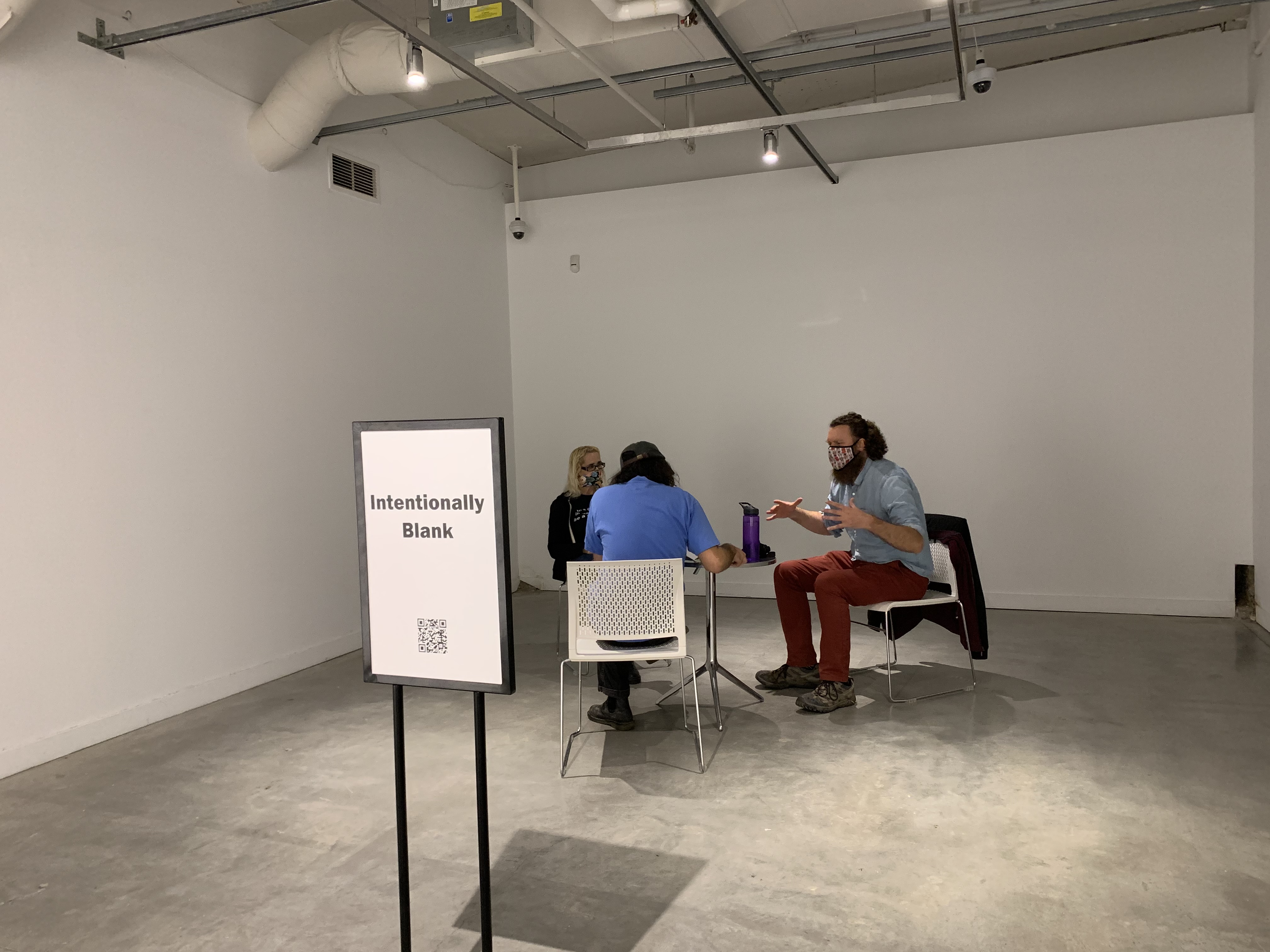
Engagement
On view at Urban Arts Space from May 24-June 11, 2021, Willfully Neglected presented a collaboration between Christian Casas (MFA Art, Department of Art) and Mona Gazala (MFA Art, recent Ohio State alumn), in which the artists explored parallel and divergent aspects of expulsion, migration and identity as expressed through text, archival material, and family histories. Through a wide-ranging dialogue as part of Episode 6 of Dear Fellow Settler Colonizer podcast, Minus Plato (Richard Fletcher, Professor, Dept of AAEP) engages the artists with core issues ranging from the use of text in visual artwork and the medium of radio to ideas of land acknowledgment as appeasement and settler shame when confronted with living legacies of colonial violence. (Originally aired Friday June 18th) 2pm EST.)
Through collaboration, connections, and partnerhsips, Urban Arts Space engaged students and faculty from OSU’s visual arts units with external audiences and built bridges between the university and the greater arts community. Working in close cooperation with faculty arts leaders and OSU’s visual arts units, Urban Arts Space dedicated space and resources for agile, collaborative, and experimental arts creation, teaching, and programming opportunities. A Faculty Advisory Council, with representation from across the Arts units was established and provided direction and critical oversight along with helping to spread awareness of available programming opportunities.
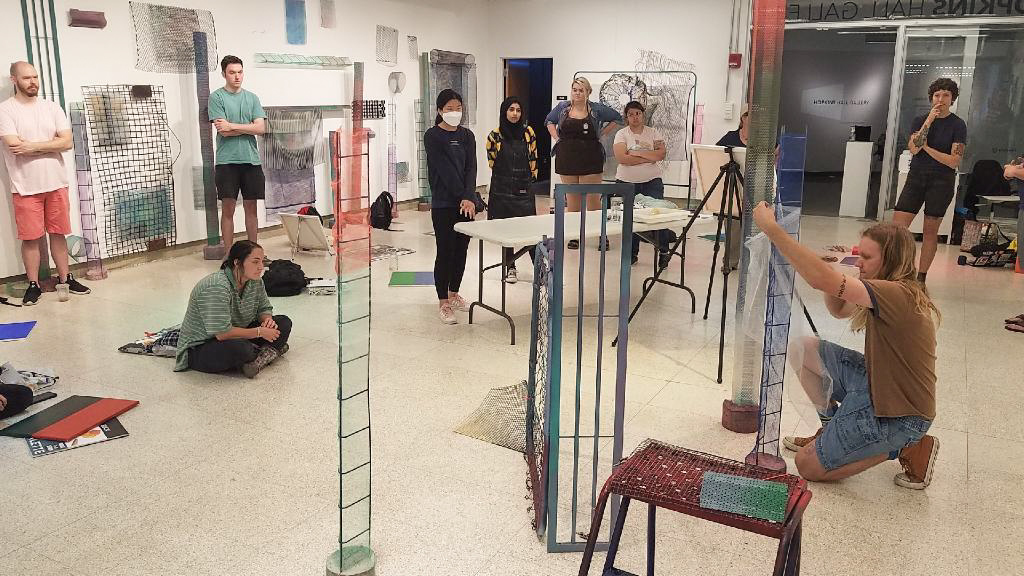
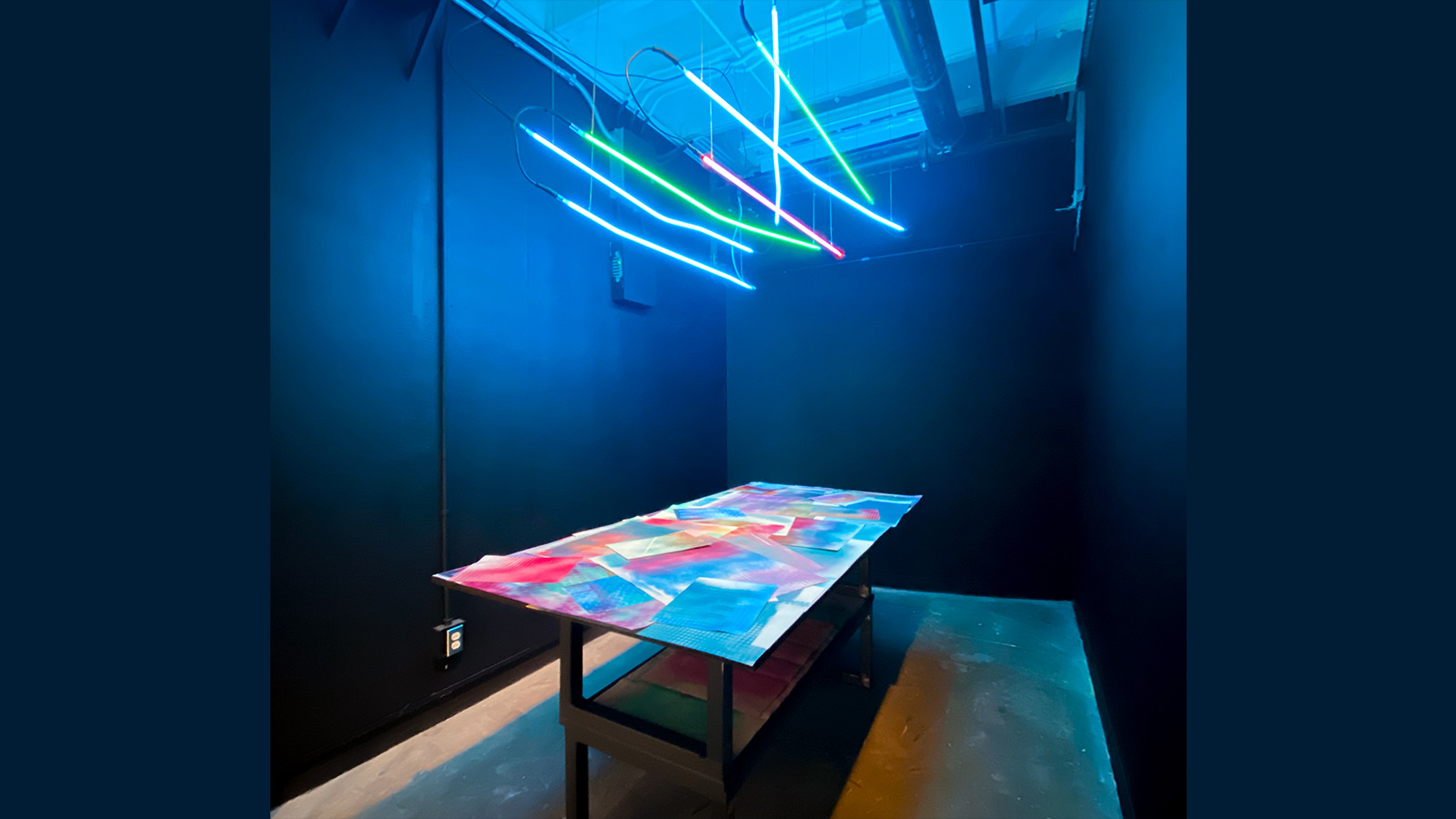
On view at Hopkins Hall Gallery from July 6-16, 2021 and at UAS Online through November 15, I Can See Clearly Now is a collaborative installation that exists as a mix between painting, sculpture, and set, by Department of Art graduate students Aaron Peters and Lydia Smith. Inspired by a Jimmy Cliff song: “I can see clearly now, the rain is gone. I can see all obstacles in my way” the artists set out to layer and weave together porous materials that viewers could look through and move around in response to our current pandemic landscape and conditions. This exhibition evolved and transformed over the course of two weeks while it was on view with various members of the community collaborating and staging interventions in the gallery space through music, dance, lighting design, performance, film projection, and teaching.
Capacity
Ensuring sustainability through adequate human and financial resources, a short term staffing model needs assessment was conducted in Summer 2021 to understand the human resources needed to carry out intermediate and long term strategic goals. With an internal focus on optimizing workflow and retooling position descriptions, two new personnel searches launched in September to fill recent staff vacancies. In addition to full-time staffing resources, Urban Arts Space’s Internship Program offers Ohio State University students the opportunity to gain comprehensive experiences in the operation of the College of Arts and Sciences’ Urban Arts Space (UAS) and Hopkins Hall Gallery (HHG) and prepares them in their professional pursuits. Student interns support specialized positions, guided by professional staff, to advance the mission of the galleries through the delivery of exhibitions, programming, and events. Interns are integral members of the staff and support daily operations through active learning experiences, hand-on projects, and group collaborations. Every position at UAS is vital to its front-line operations.
Thank you
Thank you to the faculty, students and staff in arts units (AAEP, Art, Creative Writing, Dance, Design, History of Art, Music, Theatre, Film and Media Production); thank you Hybrid Arts Lab Committee and the Summer Series Committee for their invaluable input and expertise.
Hybrid Arts Lab Committee
Ryan Skinner
Dana Carlisle Kletchka
Daniel Marcus
Marcus Jackson
Matt Lewis
Roger Beebe
Vera Brunner-Sung
Tom Dugdale
Summer Series Committee
Lisa McLymont
Andy Meyer
Tracie McCambridge
John Thrasher
Larry Williamson, Jr.

Urban Arts Space is supported by the Ohio Arts Council, which receives support from the State of Ohio and the National Endowment for the Arts.





